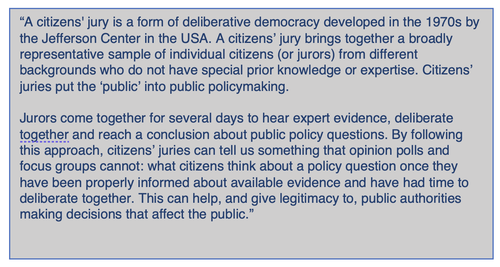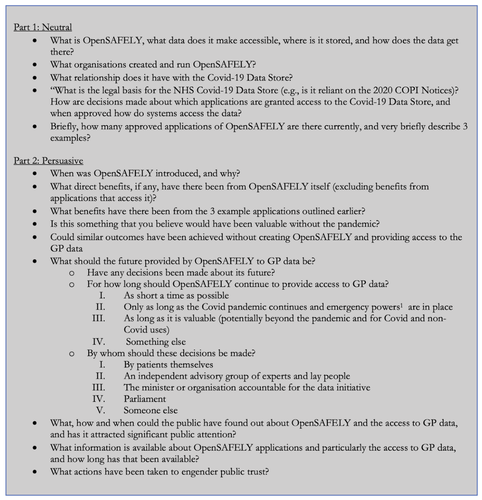This week sees the publication of an independent Citizens’ Jury commissioned for NHSx and the National Data Guardian which found that OpenSAFELY was by far the most strongly and consistently supported of all NHS COVID data projects examined. In this blog post we give some background to the Citizens Jury, our technical work to respect patients’ privacy, and the details of the Jury findings.
Since May 2020 OpenSAFELY has been used to deliver life-saving insights into the COVID-19 pandemic, delivering data analysis across the full pseudonymised health records of between 40% and 96% of the English population. Working with this scale of data is a privilege that we take very seriously. Indeed, we take it so seriously that we developed and implemented a range of new methods specifically to meet the privacy concerns of patients, professionals, and privacy campaigners. Our tools block researchers from downloading, or even viewing, the raw patient data being analysed. This in turn allows us to safely share public logs of all actions in the platform, transparently with the public. You can read an accessible description of how our tools work at the OpenSAFELY website: it is long, but we think it is important that any interested person is able to see and understand how the platform operates (for the same reason, we even share all our source code with the research community). We invested time and effort to develop these additional privacy and transparency safeguards, because we wanted to do more than communications alone to gain public trust. Our aim is to be provably trustworthy.
This is not an easy aim to achieve. We know that whilst people are generally comfortable with their health data being used for research, we also know that public trust in the NHS’s use of patient data has been badly damaged in the past, and regaining it is not necessarily straightforward given variation in public opinion about what it means for data-use to be trustworthy. For this reason, we have always felt it important to not simply rely on our own assumptions of what it means for a secure analytics platform to be ‘provably trustworthy;’ independent evaluation and validation of our design and approach has always been key.
From the beginning we have worked closely with NHS England’s Information Governance team, and sought advice and input from technical experts, privacy specialists, and those well-versed in public opinion on the use of health data. Our OpenSAFELY Oversight Board is comprised of members representing the lay public, clinicians, data ethicists, privacy campaigners, and more. However, we still wanted more input from the public. This is why we were thrilled to be asked to participate in a recent series of Citizens’ Juries (see box 1) on health data sharing in a pandemic commissioned by NIHR ARC-GM, NHSX, and the National Data Guardian, and run by ‘Citizens Juries CIC’ and the Center for New Democratic Processes.

Box 1: What is a Citizens’ Jury? See here
Data Sharing in a Pandemic Citizens’ Juries
The juries were commissioned to address key policy questions arising from the ways in which health and social care data sharing changed during the pandemic and from new initiatives developed to facilitate sharing, such as: should these data sharing initiatives, created under temporary legal powers to tackle COVID-19, continue beyond the pandemic and if so for how long? Who should make these policy decisions?
To answer these questions, each jury, of which there were three each comprised of a cross-section of 18 adults from different regions in England, spent eight days listening to evidence and deliberating on three national data sharing initiatives which were introduced to tackle the pandemic. OpenSAFELY was one of these initiatives. The other two were: the Summary Care Record additional information initiative, and the NHS COVID-19 Data Store and Data Platform.
Each jury watched a presentation from the expert witnesses for each initiative, and were then given the opportunity to ask questions of each witness. Our policy lead, Jess Morley was our expert witness, covering the questions in Box 2 in a half an hour presentation. Slides are available in this pack.

Box 2: Brief for the expert witness presentation
After the presentations and Q&A sessions from all the expert witnesses, jurors were asked the following questions about each of the initiatives:
How supportive are you of the decision to introduce this data sharing initiative in 2020 as part of tackling the COVID-19 outbreak?
- What are the most important reasons to be supportive?
- What are the most important reasons to oppose the initiative?
- For how long should the initiative continue?
- By whom should these decisions be made?
- How could or should the initiative and its uses be usefully changed in the future (if at all?)
- What actions, if any, could be taken to engender greater public trust in the initiative?
- What are your reasons for opposing the initiative?
OpenSAFELY results: reasons for support
The responses for OpenSAFELY across all three juries were overwhelmingly positive. 100% of jurors were supportive of the decision for OpenSAFELY to be introduced (77% very much in support, 23% broadly supportive). All three juries had more jurors “very much in support’ of OpenSAFELY than for the other initiatives. As such 87% of jurors believed that OpenSAFELY should continue for as long as it is valuable (potentially beyond the pandemic), provided the decision to keep it running is made by an independent advisory group of experts and lay people. See Figures 1 and 2 for more detail. Most, importantly, in terms of achieving our aim, support for introducing and maintaining OpenSAFELY was much higher than for the other initiatives because it was considered to be more transparent (and therefore trustworthy). Example reasons given for supporting OpenSAFELY (see here here and here) are outlined in Box 3. These comments demonstrate that the public understand the technical design of OpenSAFELY and appreciate the impact this has on its trustworthiness, providing us with a much-sought independent validation of our innovative approach to preserving patient privacy.

Figure 1: ‘How supportive are you of the decision to introduce this data sharing initiative in 2020 as part of tackling the COVID-19 outbreak? (from report here)

Figure 2: ‘For how long should the initiative continue?’ (from report here)

Box 3: Example reasons for supporting OpenSAFELY given by juries 1,2 and 3
OpenSAFELY results: Opportunities for Improvement
Of course, there are always opportunities to improve. Jurors felt that we could do more to communicate the results of analyses using OpenSAFELY in an accessible form, that we could publish any contracts we have with the government, and that we should be transparent about ongoing discussions to sort out information governance approvals once the current COPI notice expires. In response, we have designed and launched a new website with considerably more content available for lay audiences; commissioned an animated explainer video; and started to publish all minutes from our OpenSAFELY Oversight Board (next meeting in September). We will also work to ensure all our papers have plain English summaries, and ensure decisions made by NHS England about future information governance arrangements are communicated transparently.
Key Takeaways
Overall, these results show that we have considerable public support for continuing the development of OpenSAFELY — something which we are thrilled about. The principles underpinning all our design decisions clearly resonate with the public as much as they do with technical audiences, and our continued commitment to them is helping us achieve our aim of being ‘provably trustworthy.’ We intend to explain these principles, and how we turn them into practice, in much more detail in the coming months. In particular, we intend to explain how these principles can be applied in a generalisable fashion to other NHS data sharing initiatives, so that NHS organisations can act on the key lesson of data sharing during the pandemic, as expressed by the jurors, and develop secure joined-up data storage arrangements for future service planning and patient care.
For now, we would like to thank the Citizens Jury CIC and the Center for New Democratic Processes, for the opportunity to participate and the jurors for taking the time to provide us with such a detailed evaluation of OpenSAFELY, and to point anyone interested in reading more to the full report from the Citizens Juries.



